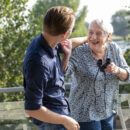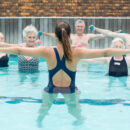Engaging Seniors with Visual Impairment: Activities and Adaptations
Discover the best activities and adaptations for seniors with visual impairments, along with practical tips to enhance their quality of life and keep them engaged. Click to explore ways to support independence and joy for your loved ones.

Staying active and engaged is vital for seniors, especially those with visual impairments. Regular participation in activities boosts physical health, cognitive function, and emotional well-being. For those with vision challenges, finding suitable activities can be difficult, but it’s essential for maintaining independence and a sense of purpose.
In this article from Koelsch Communities, we’ll explore practical and effective ways to engage visually impaired seniors, focusing on activities and adaptations that promote an enriching and inclusive lifestyle. By understanding these options, families and caregivers can help blind or visually impaired older Americans stay connected and thrive within their communities. Let’s get started!
Causes and Types of Visual Impairment in Older Adults
Common Age-Related Visual Conditions
As people age, certain conditions can impair vision. Macular degeneration damages the retina, affecting the center of the field of vision, making it difficult to recognize faces or read. Glaucoma builds pressure in the eye, damaging the optic nerve and often leading to peripheral vision loss. Cataracts cloud the eye’s lens, reducing clarity and making bright lights overwhelming. These conditions are common, and each one presents unique challenges that need specific adaptations to maintain quality of life for people with low vision.
How Visual Impairment Affects Daily Life
Vision loss can disrupt routines and limit independence. Tasks like reading, cooking, and moving through familiar spaces may become frustratingly difficult. Seniors might struggle with recognizing faces, crossing streets safely, or even managing medications. These challenges can lead to reduced social interaction, isolation, and a decline in overall well-being if not addressed properly.
How to Adapt Activities for Seniors with Visual Impairment
Sensory Substitutions
To engage visually impaired seniors, activities can be modified to rely on touch and sound. Using textured items like sandpaper, clay, or fabrics offers tactile stimulation during crafts or physical exercises, making them accessible without sight. Games that incorporate sound, such as audio puzzles or musical chairs, provide guidance and keep seniors involved. By adding simple auditory cues—like verbal instructions or sound markers—seniors can confidently participate despite their visual impairments.
Using Adaptive Technology
Adaptive technology empowers seniors by making everyday tasks manageable. Voice-controlled devices like smart assistants allow access to audiobooks, reminders, and music hands-free. Specialized apps transform smartphones into magnifiers or reading devices, offering screen reading capabilities for those with low vision. Large-button devices and talking clocks also support daily activities and help older adults stay as independent as possible. Using adaptive tools to personalize living spaces creates a more engaging and supportive environment where visually impaired seniors remain active and connected.
Safe and Enjoyable Physical Activities
Walking Groups and Mobility Exercises
Walking groups offer a safe and social way for visually impaired seniors to stay active and enjoy the benefits of physical exercise. Participants walk together in familiar areas, often with guides or volunteers providing companionship and encouragement. Mobility exercises, like leg lifts, ankle rotations, or seated stretches, are ideal for improving balance and maintaining strength, especially when done in a supportive setting. These exercises can be easily incorporated into daily routines and adapted to suit individual abilities.
Chair Yoga and Balance Workouts
Chair yoga focuses on gentle stretches and posture improvement, ideal for those with limited mobility. By following verbal cues, seniors can safely practice movements that enhance flexibility and balance. Balance exercises, like standing leg raises or using a support rail, build strength and reduce fall risks, helping maintain independence.
Tandem Cycling and Its Benefits
Tandem cycling is another fun activity that pairs visually impaired seniors with sighted partners. This activity allows them to enjoy the outdoors while pedaling safely. It promotes cardiovascular health, offers fresh air, and gives a sense of freedom.
Crafts for Visually Impaired Older Adults
Tactile Crafts
Tactile arts and crafts like pottery and clay modeling engage the senses through touch, making them ideal for seniors with visual impairments. Art and craft activities allow individuals to shape and feel their creations, providing a sensory-rich experience. Working with clay also improves hand strength and coordination, offering both a creative and physical outlet.
Knitting and Crocheting with Adaptations
Knitting and crocheting can be adapted by using textured yarns and larger needles, making it easier for those with vision impairments to distinguish stitches. These activities are calming and provide a sense of accomplishment while keeping hands and minds active.
Games and Puzzles for Seniors with Low Vision
Audio-Based Games
Audio-based games offer a stimulating way for seniors with low vision to stay mentally active. Audiobooks and trivia games engage the mind and promote social interaction. Many trivia games come with voice instructions, allowing seniors to participate easily. Story-based audio games also provide immersive experiences that spark imagination and conversation.
Braille and Large-Print Board Games
Braille and large-print board games, like tactile chess or bingo, are perfect for people with low vision. These games provide a hands-on experience, enhancing touch and encouraging strategic thinking. Many local libraries or senior living communities offer these accessible options, making them easy to find and enjoy.
The Role of Music Therapy for Visually Impaired Seniors
Benefits of Group Singing Sessions
One proven technique for elevating mood is to listen to music, and making music is even better! Group singing offers vision impaired seniors a way to connect and socialize. The familiar tunes and rhythms of favorite songs provide comfort, while the group setting encourages social interactions that boost mood and emotional well-being. Group singing sessions are accessible and do not rely on visual skills, making them an inclusive and engaging activity for visually impaired seniors.
Learning Musical Instruments Through Tactile Methods
Learning instruments using tactile techniques gives seniors the chance to explore music hands-on. Instruments like drums, keyboards, or string instruments provide sensory feedback and allow seniors to learn through touch. This builds motor skills and offers a creative outlet for older adults with visual impairment
Creating Social Opportunities for Visually Impaired Seniors
Support Groups and Community Programs
Support groups help visually impaired seniors connect with others who understand their challenges. These groups provide a space for sharing experiences, building friendships, and offering practical advice. Community programs may include guided discussions, accessible book clubs, or technology workshops that enhance social skills and independence.
Organizing Inclusive Events and Social Clubs
Communities can organize inclusive events like game nights or music sessions. These activities are designed to accommodate different levels of vision impairment. Social clubs focused on hobbies like cooking, tactile crafts, or gardening encourage interaction and create a sense of belonging.
Essential Adaptive Skills for Visually Impaired Seniors
Mobility Training and Orientation Techniques
Mobility training helps visually impaired seniors navigate their environment confidently. Helpful techniques include using white canes for detecting obstacles and landmarks, as well as practicing safe routes within the community. Orientation specialists teach skills like trailing walls and counting steps, that make it easier for seniors to move independently in familiar and new areas.
Using Assistive Devices Effectively
Assistive devices can help with vision rehabilitation and support independence in daily activities. Seniors can use talking clocks, magnifiers, or voice-activated tools to complete tasks like reading and managing their routines. Training sessions help visually impaired older adults build familiarity with these devices ensuring they become valuable tools for maintaining autonomy.
How to Help Visually Impaired Senior Citizens
Creating a Safe and Accessible Environment
Ensure spaces are well-lit and free from hazards. Use bright, even lighting in key areas like kitchens, bathrooms, and hallways. Apply tactile markers—like textured floor strips or rubber grips on handrails—on stairs and doorways to guide movement. Place important items such as remotes or phones in consistent, accessible locations. Use large-print labels or braille on frequently used objects like medication bottles, cabinets, and light switches. Keep walkways clear by avoiding clutter and securing loose cords or rugs.
Encouraging Independence While Offering Support
Introduce assistive tools like voice-command devices for reminders, reading magnifiers, and talking clocks. Practice using these together to build comfort. Encourage seniors to try tasks independently with supervision nearby. Gradually, they’ll gain confidence in handling daily routines. Support with patience and positive reinforcement and always highlight their achievements. This empowers older adults while maintaining their autonomy.
Closing Thoughts
Engaging activities are essential for improving the quality of life for visually impaired seniors. Adaptive activities, like tactile crafts, music therapy, and safe physical exercises, help maintain independence and provide mental stimulation. With the right support and thoughtful adaptations, seniors can continue to enjoy their favorite pastimes and explore new hobbies. For families seeking more personalized options, professional guidance can offer tailored solutions that fit individual needs. It’s important to seek out communities that provide a wide range of enriching and accessible activities where blind and low vision seniors can thrive confidently and comfortably.
About Koelsch Communities
Koelsch Communities offers a wide range of “Mom-approved” senior living options designed to create fulfilling and enjoyable experiences. With over 60 years of experience, we have built a reputation for providing top-quality care and exceptional living environments. Our communities are staffed by professionals dedicated to treating our Ladies and Gentlemen with respect and providing the special attention they need.
We pride ourselves on our high customer satisfaction, which reflects our commitment to excellence. Our experienced team ensures that every resident feels valued and cared for, promoting a thriving and supportive community atmosphere.
For more information about our senior living options and to discover how we can help you or your loved one enjoy the finest living experiences, please contact us today. We look forward to welcoming you to our community and helping you find the perfect senior living solution.
Disclaimer: This article is for informational purposes only and does not constitute medical, legal, or financial advice. It’s recommended to consult with a medical, legal, or financial professional for your specific circumstances.









